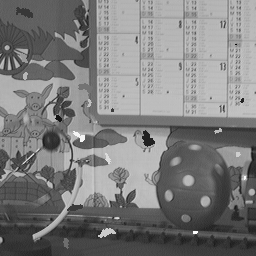

Most popular approaches treat film blotches using two-step solutions: first detection of the blotches and then interpolation of the missing data; we will follow too the same approach.
The detection step is very difficult especially due to the motion which can be inherent to the observed frames. A straightforward motion compensation is not always possible, just due to the presence of the blotches. Commonly used detectors are not robust to motion, even when it is slow, and they weakly exploit spatial information.
The second step consists of the interpolation of the missing data. In this step an accurate motion estimation is required in order to produce acceptable results. Usually information about the motion is used to temporally filter the image along the direction of the motion.
The first innovation of this approach is a new detector. Commonly used and known blotch detectors are the SDI (Spike Detection Index)and the ROD (Rank Order Detector). They exploit mainly temporal discontinuities inherent to the blotches.Our Enhanced Spatio-Temporal Detector (ESTD) exploits both temporal and spatial information in order to minimise false alarms in presence of slow motion. It takes into account object coverings and uncoverings.
The second step of the deblotching algorithm consists of an accurate estimation of the motion in order to get good motion vectors which have to be used in interpolating the missing data. For this task we need to avoid taking into account the pixels belonging to the identified blotches. We start including pixels labelled as blotches into windows of predefined size. If the ratio rho=(#correct)/(#noisy) between the number of correct and wrong pixels within the block is larger than a threshold, that block can be used for motion estimation, otherwise the window size is increased and the rho ratio is evaluated again, and so on. This approach can be seen as an adaptive Block Matching, which varies the block dimension with respect to the amount of corruption. Using this procedure good motion vectors can be obtained, which are not affected by blotches.


Results obtained applying the proposed algorithm on a artifically corrupted sequence. From left to right the corrupted and restored sequences are shown.
For information contact: tenze@ieee.org